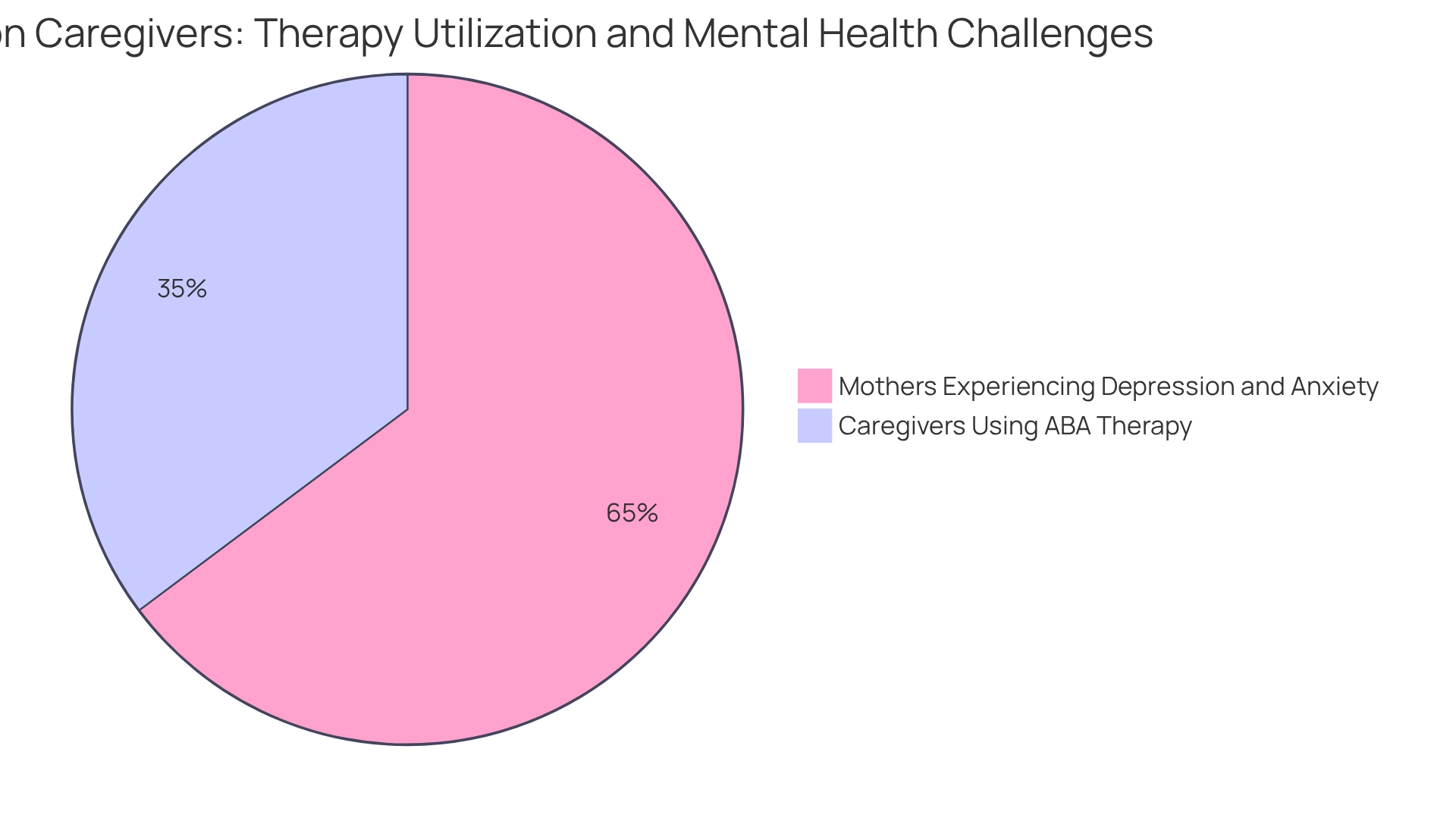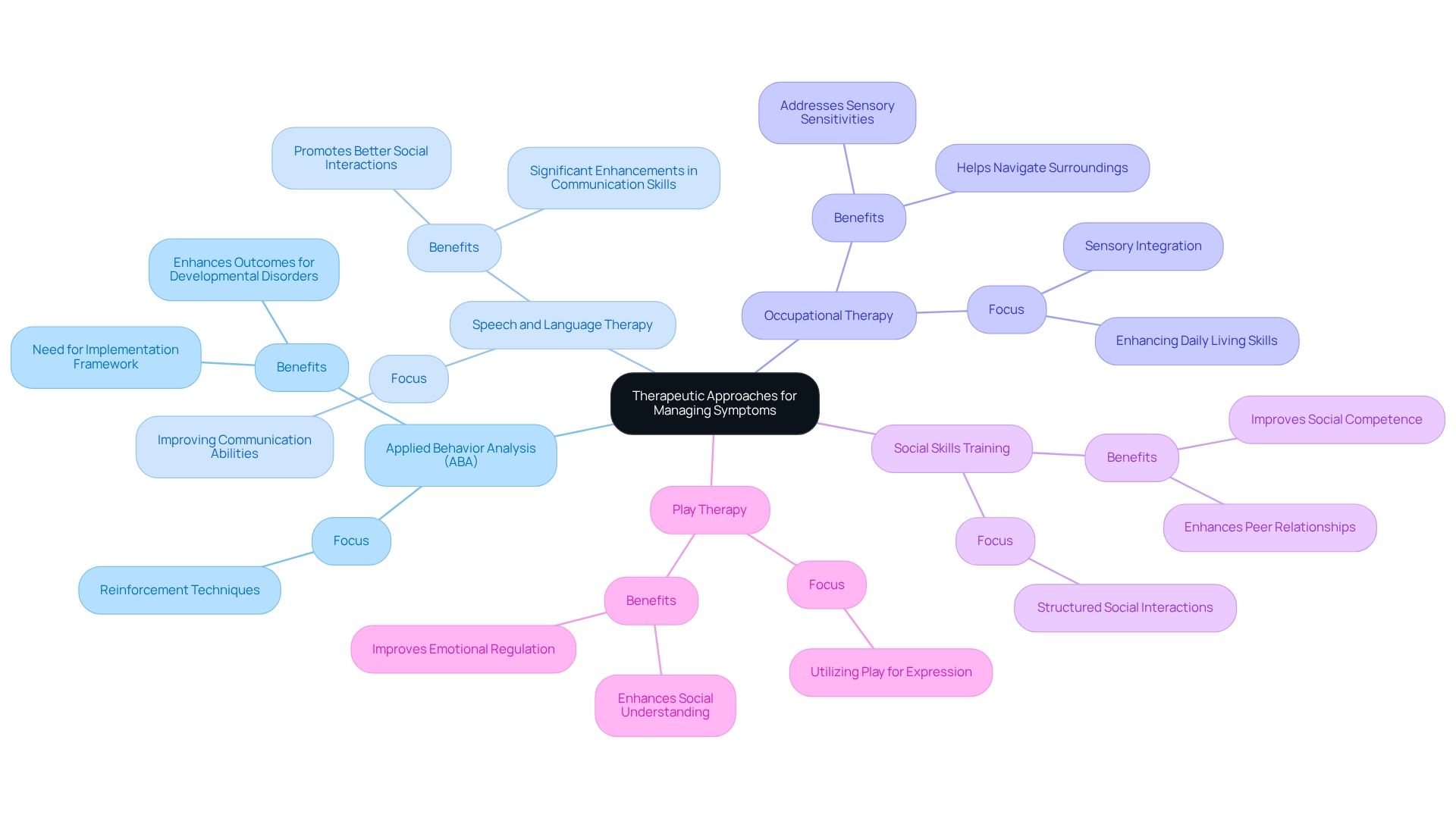Overview
Recognizing the physical symptoms of autism is crucial for early intervention. When identified promptly, these symptoms can lead to significantly improved developmental outcomes for children affected by autism. This article highlights the importance of early diagnosis, which, when paired with effective support strategies such as Applied Behavior Analysis (ABA) and speech therapy, can greatly enhance social communication skills and overall well-being. Caregivers play a vital role in this process, and their proactive engagement is essential.
As parents, understanding these signs can be overwhelming, but know that you are not alone. Many families face similar challenges, and early support can make a world of difference. Imagine the joy of seeing your child thrive socially and emotionally with the right interventions. By taking action now, you can foster an environment that nurtures their growth and development.
If you suspect your child may be showing signs of autism, consider reaching out to professionals who can provide guidance and support. Together, we can create a brighter future for our children.
Introduction
In a world where understanding neurodevelopmental conditions is more critical than ever, Autism Spectrum Disorder (ASD) stands out for its complexity and the unique challenges it presents. With a prevalence rate that continues to rise, affecting approximately 1 in 36 children as of 2025, the importance of early identification and intervention cannot be overstated. This article invites you to explore the multifaceted nature of autism, shedding light on its spectrum and physical symptoms, while emphasizing the vital role of early diagnosis.
As we delve deeper, we will highlight various therapeutic approaches that have proven effective in managing symptoms and enhancing the quality of life for individuals on the autism spectrum. Imagine the difference tailored strategies can make for those affected—it's essential to stay informed about the latest research and best practices in autism support. Together, we can foster understanding and compassion in our communities, ensuring that every child receives the support they need.
Define Autism and Its Spectrum
Autism Spectrum Disorder (ASD) is a multifaceted neurodevelopmental condition that can present challenges in social interaction, communication, and often includes repetitive behaviors. The term 'spectrum' reflects the wide variety of symptoms and severity levels, which can differ greatly from one person to another. For instance, while some individuals may exhibit remarkable visual skills, they might struggle with verbal communication. This diversity underscores the need for tailored approaches that recognize the unique strengths and challenges of each individual with ASD.
Recent studies have shown a concerning trend: the occurrence of ASD continues to rise, with data indicating that approximately 1 in 36 youth are diagnosed with the disorder as of 2025. Particularly noteworthy is the resurgence of assessments and recognition of ASD among children born in 2018, which began again by June 2020. This highlights the critical need for timely identification and effective support strategies. Initiatives like the CDC's 'Learn the Signs. Act Early.' program offer vital tools for developmental monitoring, empowering caregivers to spot early signs of delay.
Furthermore, research is revealing emerging patterns in the identification of ASD across various racial and ethnic groups, pointing to disparities in diagnosis and access to services. A case study titled 'Racial and Ethnic Differences in ASD Identification' sheds light on these inequities, emphasizing the urgent need for targeted efforts to enhance ASD identification and support within communities. Additionally, surveys show that 36.5% of caregivers for individuals with developmental disorders utilize ABA therapy, with many reporting positive outcomes. This demonstrates the effectiveness of intervention strategies.
As our understanding of ASD deepens, it is essential to stay informed about the latest studies and professional insights. This knowledge promotes a nuanced approach to defining and supporting individuals on the spectrum. We encourage you to share your experiences and thoughts in the comments or through our newsletters, fostering a community of support and understanding.
Identify Physical Symptoms of Autism
The physical symptoms of autism can manifest in various forms, profoundly impacting daily life and growth. Recognizing the physical symptoms of autism early is vital, as timely assessments and interventions can lead to significantly better outcomes. Recent studies indicate that swift identification of physical symptoms of autism allows for more effective support strategies, enhancing the overall well-being of children with developmental disorders. For example, surveys show that 36.5% of caregivers for children with autism employ ABA therapy, with many reporting positive experiences in managing these symptoms. This underscores the importance of early identification; proactive measures can pave the way for improved developmental trajectories for youth with autism.
Moreover, it is essential to acknowledge the mental health challenges faced by parents, particularly mothers. Research reveals that 67.1% of mothers of children with autism in Chang Sha, China, reported experiencing symptoms of both depression and anxiety. This statistic sheds light on the emotional strain that caring for a child with developmental challenges can place on families, highlighting the urgent need for comprehensive support systems to alleviate stress and foster healthier family dynamics. Occupational therapists stress that identifying the physical symptoms of autism promptly can lead to better outcomes not only for the children but also for their families. This reinforces the necessity of timely assistance, ensuring that both children and their caregivers receive the support they need.

Emphasize Early Diagnosis and Intervention
Research consistently shows that early diagnosis of autism is crucial for achieving better outcomes for children. When diagnosed before the age of 2.5 years, children often display improved social communication skills and adaptive behaviors compared to those diagnosed later. Early support strategies, such as Applied Behavior Analysis (ABA), speech therapy, and occupational therapy, play a vital role in helping young individuals develop essential skills and manage their symptoms effectively.
However, it’s important to note that statistics indicate the adaptive behavior composite showed a marginally insignificant result with an effect size of 0.34 (p = −0.04). This suggests that while there may be some improvement, it is not statistically significant. As parents, being proactive in seeking assessments when you notice signs of autism can make a significant difference in your child's development and overall quality of life.
Communicating your observations with your child's healthcare provider is essential. If you have concerns about your child's development, don't hesitate to seek guidance. Case studies related to early diagnosis and intervention emphasize the importance of these strategies, reinforcing the need for parents to engage actively with healthcare professionals. Your involvement can be a powerful catalyst for your child's growth and happiness.
Explore Therapeutic Approaches for Managing Symptoms
A range of therapeutic methods can effectively address the symptoms of the condition, each customized to meet the individual requirements of the young person.
- Applied Behavior Analysis (ABA): This evidence-based approach utilizes reinforcement techniques to encourage positive behaviors while decreasing challenging ones. Research shows that ABA can greatly enhance results for youth with developmental disorders, establishing it as a fundamental aspect of treatment. However, as highlighted in a recent study, there is a need for a deployment framework for mandates related to developmental disorders to ensure these approaches lead to significant patient outcomes.
- Speech and Language Therapy: This therapy focuses on improving communication abilities, which is vital for non-verbal or minimally verbal youth. Research indicates that early intervention in speech therapy can lead to significant enhancements in communication skills, promoting better social interactions.
- Occupational Therapy: Concentrating on enhancing daily living skills and sensory integration, occupational therapy helps young individuals navigate their surroundings more effectively. This method is particularly beneficial for addressing sensory sensitivities that many youth with developmental disorders experience.
- Social Skills Training: This structured strategy provides youngsters with opportunities to engage in social interactions within a nurturing environment, aiding them in developing essential social abilities. Evidence suggests that such training can enhance peer relationships and social competence.
- Play Therapy: By utilizing play as a medium, this therapy allows young individuals to express themselves and develop social skills in a natural context. It has been shown to improve emotional regulation and social understanding among children on the spectrum.
Each of these therapeutic methods plays a crucial role in fostering growth and development across various areas, ultimately leading to an improved quality of life for children on the spectrum. However, as Karen J Coleman, PhD, MS, notes, even in contexts with mandated commercial insurance coverage for ABA, challenges in health system implementation may limit the effectiveness of these interventions. Furthermore, future studies are encouraged to explore reasons for service discontinuation and to incorporate additional patient outcome measures beyond adaptive behavior, providing a more comprehensive view of the current landscape of autism therapy.

Conclusion
Understanding Autism Spectrum Disorder (ASD) is essential for addressing the unique challenges that individuals and their families face. With approximately 1 in 36 children diagnosed, early identification and intervention are crucial for nurturing positive developmental outcomes. Initiatives like the CDC's 'Learn the Signs. Act Early.' empower caregivers to recognize early signs of autism, enabling timely support.
Physical symptoms, such as repetitive movements and sensory sensitivities, can profoundly influence daily life. Early recognition paves the way for prompt assessments and interventions that enhance the well-being of children with autism, while also alleviating the emotional toll on families.
Research underscores that children diagnosed before age 2.5 exhibit better social communication and adaptive behaviors. Effective therapeutic approaches, including Applied Behavior Analysis (ABA), speech therapy, and occupational therapy, play a pivotal role in managing symptoms and improving quality of life. However, ensuring that these interventions are accessible to all families is of utmost importance.
Ultimately, fostering community understanding and compassion is vital for supporting individuals on the autism spectrum. By staying informed about the latest research and best practices, we can cultivate an environment where every child with autism receives the necessary care and resources to thrive. Advocating for early intervention together can lead to meaningful improvements in the lives of those affected by autism.
Frequently Asked Questions
What is Autism Spectrum Disorder (ASD)?
Autism Spectrum Disorder (ASD) is a multifaceted neurodevelopmental condition characterized by challenges in social interaction, communication, and often includes repetitive behaviors. The term 'spectrum' indicates the wide variety of symptoms and severity levels that can differ greatly among individuals.
How prevalent is Autism Spectrum Disorder?
As of 2025, approximately 1 in 36 youth are diagnosed with Autism Spectrum Disorder, indicating a concerning rise in occurrences.
What recent trends have been observed in the diagnosis of ASD?
There has been a notable resurgence in the assessment and recognition of ASD, particularly among children born in 2018, which began again by June 2020. This highlights the importance of timely identification and effective support strategies.
What resources are available for early detection of ASD?
The CDC's 'Learn the Signs. Act Early.' program provides vital tools for developmental monitoring, helping caregivers to identify early signs of delay in children.
Are there disparities in the diagnosis of ASD across different communities?
Yes, research indicates emerging patterns in the identification of ASD across various racial and ethnic groups, revealing disparities in diagnosis and access to services. Targeted efforts are needed to enhance ASD identification and support within these communities.
What intervention strategies are commonly used for individuals with ASD?
Surveys show that 36.5% of caregivers for individuals with developmental disorders utilize ABA (Applied Behavior Analysis) therapy, with many reporting positive outcomes, demonstrating the effectiveness of such intervention strategies.
Why is it important to stay informed about ASD?
Staying informed about the latest studies and professional insights regarding Autism Spectrum Disorder promotes a nuanced approach to defining and supporting individuals on the spectrum, which is essential for effective intervention and community support.




